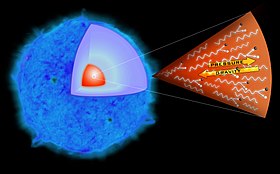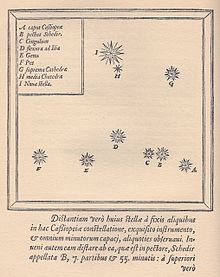 | |
| Event type | Astronomical radio source, astrophysical X-ray source |
|---|---|
| Type Ia[1] | |
| Date | November 1572 |
| Constellation | Cassiopeia |
| Right ascension | 0h 25.3m |
| Declination | +64° 09′ |
| Epoch | ? |
| Galactic coordinates | G.120.1+1.4 |
| Distance | between 8,000 ly (2.5 kpc) and 9,800 ly (3.0 kpc) |
| Remnant | Nebula |
| Host | Milky Way |
| Progenitor | Unknown |
| Progenitor type | Unknown |
| Colour (B-V) | ~1 |
| Peak apparent magnitude | −4 |
| Other designations | SN 1572, HR 92, SN 1572A, SNR G120.1+01.4, SNR G120.2+01.4, 1ES 0022+63.8, 1RXS J002509.2+640946, B Cas, BD+63 39a, 8C 0022+638, 4C 63.01, 3C 10, 3C 10.0, 2C 34, RRF 1174, 1XRS 00224+638, 2U 0022+63, 3A 0022+638, 3CR 10, 3U 0022+63, 4U 0022+63, AJG 112, ASB 1, BG 0022+63, CTB 4, KR 101, VRO 63.00.01, [DGW65] 3, PBC J0024.9+6407, F3R 3628, WB 0022+6351, CGPSE 107, GB6 B0022+6352 |
| Preceded by | SN 1181 |
| Followed by | SN 1604 |
| | |
SN 1572 (Tycho's Supernova, Tycho's Nova), or B Cassiopeiae (B Cas), was a supernova of Type Ia in the constellation Cassiopeia, one of eight supernovae visible to the naked eye in historical records. It appeared in early November 1572 and was independently discovered by many individuals.
Its supernova remnant has been observed optically but was first detected at radio wavelengths; it is often known as 3C 10, a radio-source designation, although increasingly as Tycho's supernova remnant.
Historic description
The appearance of the Milky Way supernova of 1572 belongs among the most important observation events in the history of astronomy. The appearance of the "new star" helped to revise ancient models of the heavens and to speed on a revolution in astronomy that began with the realisation of the need to produce better astrometric star catalogues (and thus the need for more precise astronomical observing instruments). It also challenged the Aristotelian dogma of the unchangeability of the realm of stars.[2]
The supernova of 1572 is often called "Tycho's supernova", because of Tycho Brahe's extensive work De nova et nullius aevi memoria prius visa stella ("Concerning the Star, new and never before seen in the life or memory of anyone", published in 1573 with reprints overseen by Johannes Kepler in 1602 and 1610), a work containing both Brahe's own observations and the analysis of sightings from many other observers. Comparisons between Brahe's observations and those of Spanish scientist Jerónimo Muñoz[3] revealed that the object was more distant than the Moon.[4] This would lead Brahe to approach the Great Comet of 1577 as an astronomical body as well.[2] Other Europeans to sight the supernova included Wolfgang Schuler, Christopher Clavius, Thomas Digges, John Dee, Francesco Maurolico, Tadeáš Hájek, and Bartholomäus Reisacher.[5]
In England, Queen Elizabeth had the mathematician and astrologer Thomas Allen come and visit "to have his advice about the new star that appeared in the Swan or Cassiopeia ... to which he gave his judgement very learnedly", as the antiquary John Aubrey recorded in his memoranda a century later.[6]
In Ming dynasty China, the star became an issue between Zhang Juzheng and the young Wanli Emperor: in accordance with the cosmological tradition, the emperor was warned to consider his misbehavior, since the new star was interpreted as an evil omen.[7]
The more reliable contemporary reports state that the new star itself burst forth soon after November 2, and by November 11 it was already brighter than Jupiter. Around November 16, 1572, it reached its peak brightness at about magnitude −4.0, with some descriptions giving it as equal to Venus when that planet was at its brightest.[8] Contrarily, Brahe described the supernova as "brighter than Venus".[2] The supernova remained visible to the naked eye into early 1574, gradually fading until it disappeared from view.[8]
https://en.wikipedia.org/wiki/SN_1572
SN 1000+0216 was an extremely remote superluminous supernova (SLSN), which occurred in between June and November 2006 in the constellation Sextans. Its peak far-ultraviolet absolute magnitude reached −21.5, which exceeded the total absolute magnitude of its host galaxy. The distance (redshift) to this supernova z=3.8993 ± 0.0074 makes it the most distant supernova observed as of 2012. The luminosity of SN 1000+0216 evolved slowly over several years as it was still detectable in November 2008. Both the high luminosity and slow decay indicate that the supernova's progenitor was a very massive star. The supernova explosion itself was likely either a pair-instability supernova or a pulsational pair-instability supernova similar to the SN 2007bi event. It also had some similarities to the low redshift SN 2006gy supernova. Overall classification of SN 1000+0216 remains uncertain.[2]
 The pair instability process that triggered the explosion in SN 1000+0216 | |
| Event type | Supernova |
|---|---|
| SLNS-R or SLNS-II ? | |
| Date | Supernova Legacy Survey |
| Constellation | Sextans |
| Right ascension | 10h 00m 05.8720s[1] |
| Declination | +02° 16′ 23.621″[1] |
| Epoch | J2000.0 |
| Distance | z=3.8993 ± 0.0074 |
| Redshift | 3.8993 ±0.0074 |
| Progenitor | initially a 140–250 M☉ star |
https://en.wikipedia.org/wiki/SN_1000%2B0216

No comments:
Post a Comment